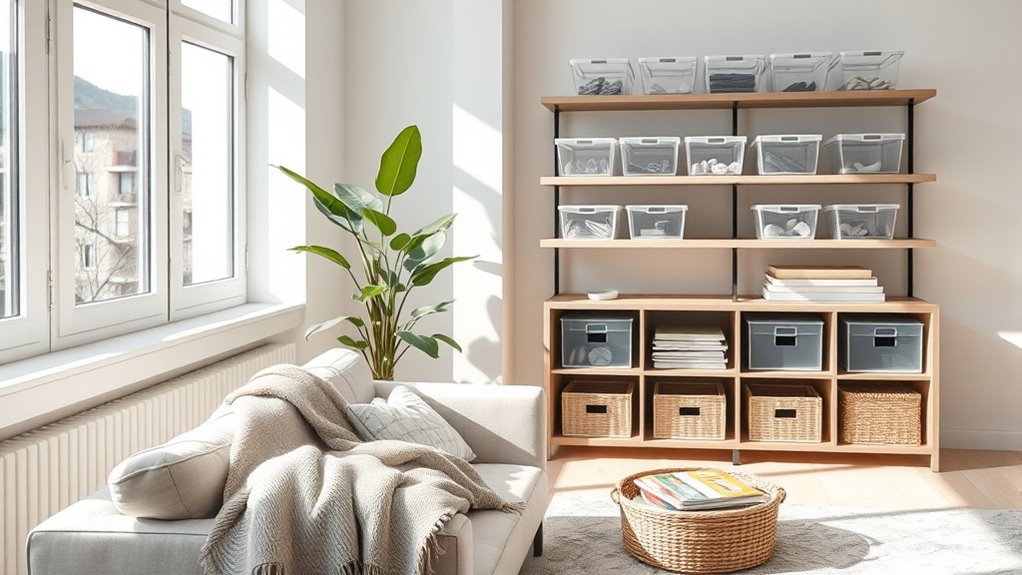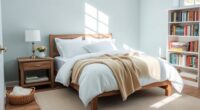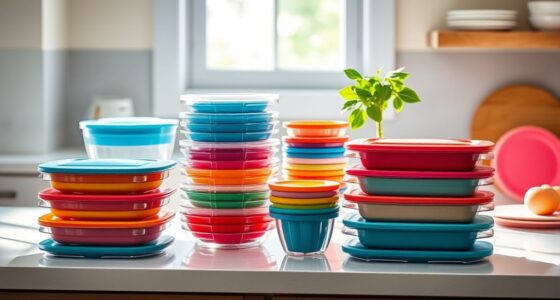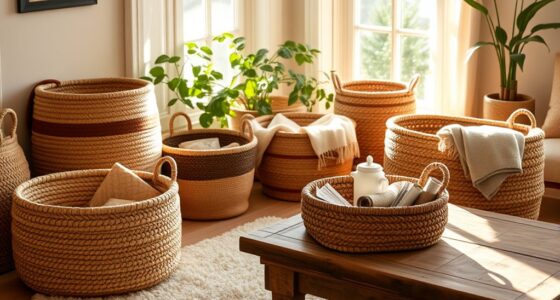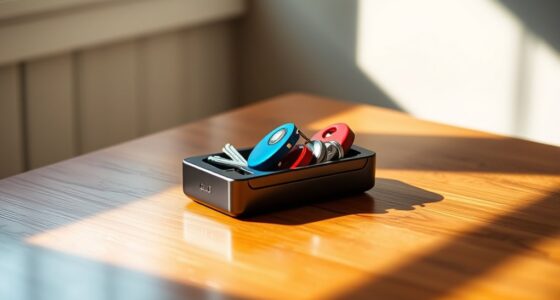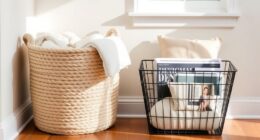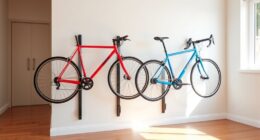As I explored the best decluttering products for 2025, I found seven essentials that can really transform your space. From easy-to-use organizing tools to storage solutions that match your style, these products make creating a clutter-free home a breeze. I love how they simplify the process and keep me motivated. If you're curious about my top picks and how they can work for you, there's so much more to share!
Key Takeaways
- Look for multifunctional storage solutions like ottomans or storage benches to save space and enhance utility in your home.
- Invest in durable and high-quality organizers, such as bins and baskets, to ensure long-term effectiveness and reduce clutter.
- Utilize room-by-room checklists to systematically tackle areas, making decluttering more manageable and less overwhelming.
- Consider aesthetically pleasing storage options that complement your existing decor while helping to maintain a clutter-free environment.
- Set a clear budget for decluttering products to avoid overspending and help prioritize essential items for an organized space.
Making Space, Clutter Free: The Last Book on Decluttering Youll Ever Need
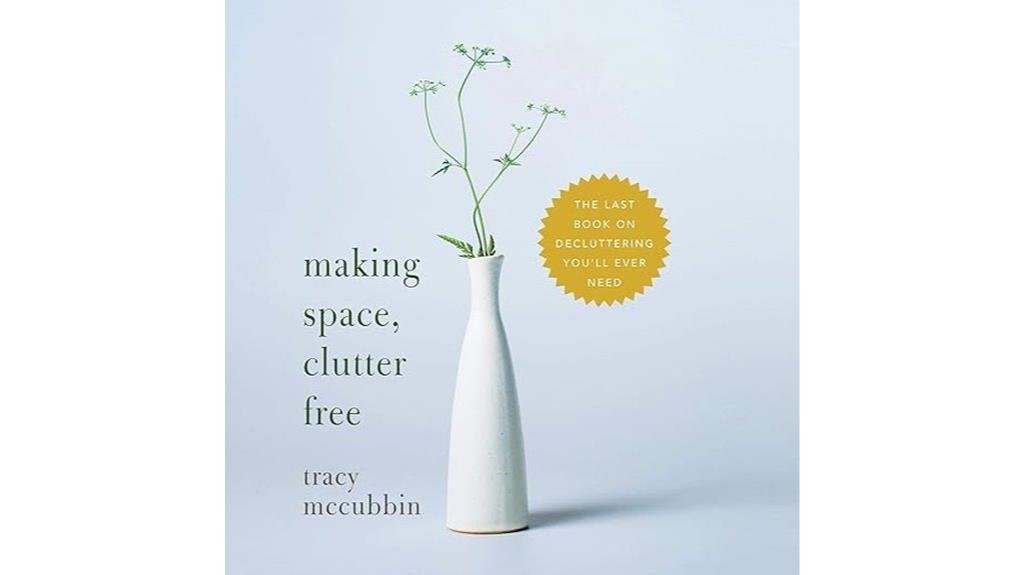
If you've ever felt overwhelmed by the clutter in your home and struggled to let go of items that no longer serve you, "Making Space, Clutter Free: The Last Book on Decluttering You'll Ever Need" is the perfect guide for you. This book truly resonated with me, as it addresses not just physical clutter but also the emotional blocks we face. The author's practical steps made decluttering manageable, and their engaging presence on social media kept me motivated. I appreciated the insights into why I held onto certain items, making it easier to overcome those barriers. It's a game-changer for anyone seeking clarity.
Best For: Individuals seeking to declutter their homes while addressing the emotional aspects of their attachment to belongings.
Pros:
- Addresses emotional clutter: The book helps readers understand the emotional triggers behind their attachment to items, making it easier to let go.
- Practical strategies: It provides clear and actionable steps for decluttering, making the process accessible for everyone.
- Engaging author presence: The author actively engages with readers on social media, offering motivation and support throughout their decluttering journey.
Cons:
- May require time commitment: The emotional exploration of clutter can take time, which some readers may find challenging.
- Not a one-size-fits-all solution: While the strategies are effective, some individuals might need more tailored advice based on unique situations.
- Potential for emotional discomfort: Delving into the reasons behind clutter can bring up uncomfortable feelings for some readers, which may be a barrier to progress.
Stop Organizing and Declutter: The Quick Guide to a Clutter Free Home
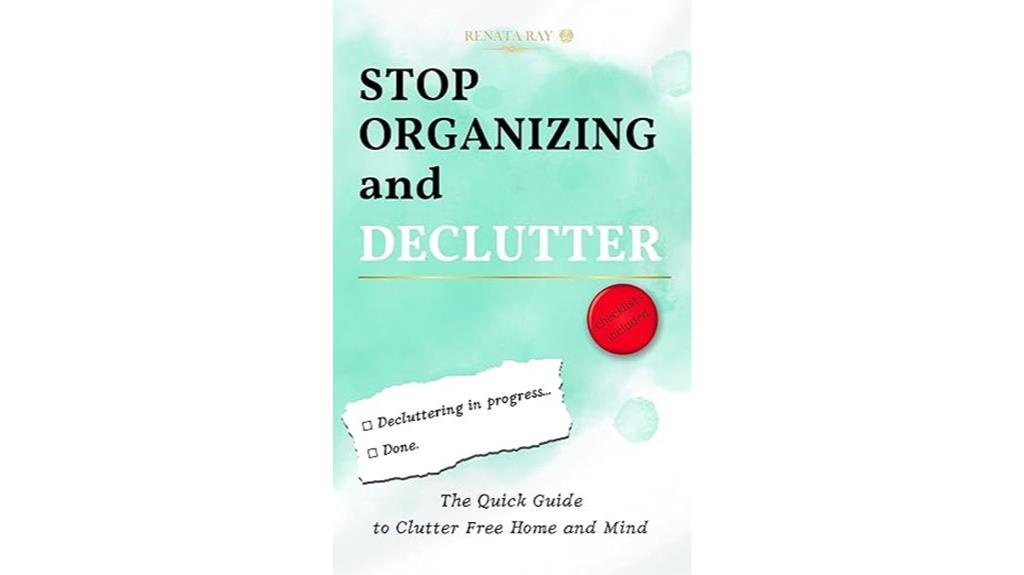
For anyone feeling overwhelmed by clutter, "Stop Organizing and Declutter: The Quick Guide to a Clutter Free Home" offers a revitalizing approach that prioritizes emotional clarity over mere tidiness. This book transformed my perspective on decluttering, focusing on the emotional ties we have to our belongings. It taught me that healing emotional wounds can lead to physical space and mental freedom. With practical tips from an architect's viewpoint, I found the process manageable. While some psychological insights may feel excessive, the holistic approach truly resonates, making my home not just organized but a peaceful sanctuary that nurtures my well-being.
Best For: Individuals seeking emotional clarity and practical guidance in their decluttering journey to create a peaceful living environment.
Pros:
- Holistic Approach: Emphasizes the connection between emotional well-being and physical space, fostering a deeper understanding of clutter.
- Practical Tips: Offers insightful advice from an architect's perspective, making decluttering feel manageable and achievable.
- Inspiring Narrative: Motivates readers by linking personal growth with the decluttering process, encouraging healing and transformation.
Cons:
- Excessive Focus on Psychology: Some readers may find the initial emphasis on psychological insights overwhelming or unnecessary.
- Comparative Style: Others might prefer a more engaging narrative style found in similar works, such as those by Don Aslett.
- Limited Practicality: A few readers may desire more straightforward organizational strategies rather than a holistic approach.
Keep the Memories, Lose the Stuff: Declutter and Downsize Guide
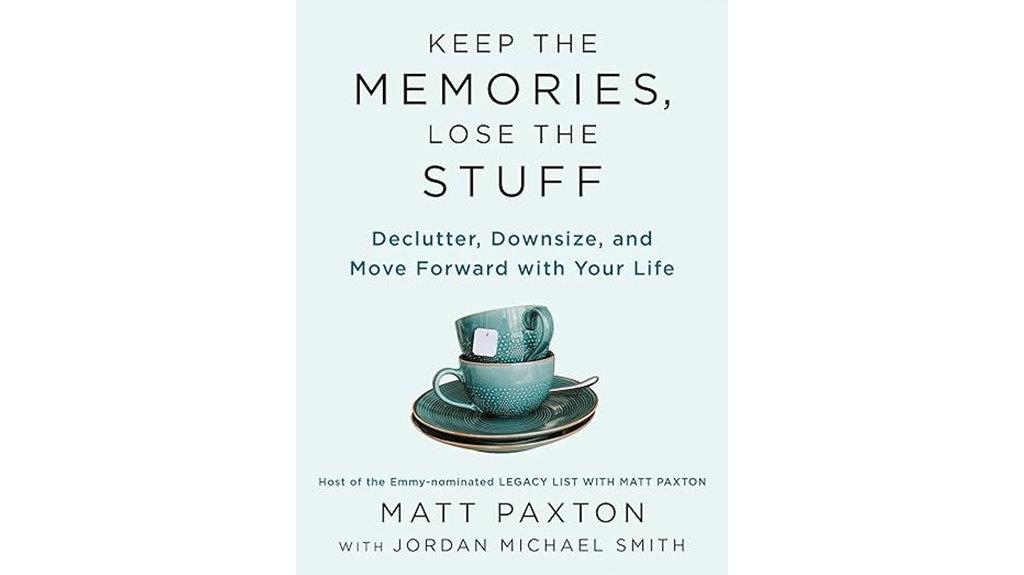
Feeling overwhelmed by your belongings is a common struggle, especially during significant life changes like downsizing or moving. I recently read "Keep the Memories, Lose the Stuff" by Matt Paxton, which offers practical advice for letting go. Paxton emphasizes that memories matter more than physical items. He suggests creating a Legacy List to honor what's significant and sharing stories about cherished items. I found his tips on tackling small areas daily and accepting inherited items don't have to stay incredibly helpful. Remember, it's okay to let go—after all, your memories can live on without the clutter.
Best For: Individuals feeling overwhelmed by their belongings, particularly those going through life transitions such as moving or dealing with the estates of deceased loved ones.
Pros:
- Offers practical and actionable tips for effective decluttering and downsizing.
- Encourages emotional healing by focusing on memories rather than physical possessions.
- Provides a structured approach through the Legacy List to honor significant items and stories.
Cons:
- Emotional challenges may still arise during the decluttering process, which some may find difficult to navigate.
- The process requires time and commitment, which may not be feasible for everyone.
- Some readers may find it hard to let go of sentimental items despite the guidance provided.
Doable Decluttering Workbook: Proven Methods to Organize Your Home
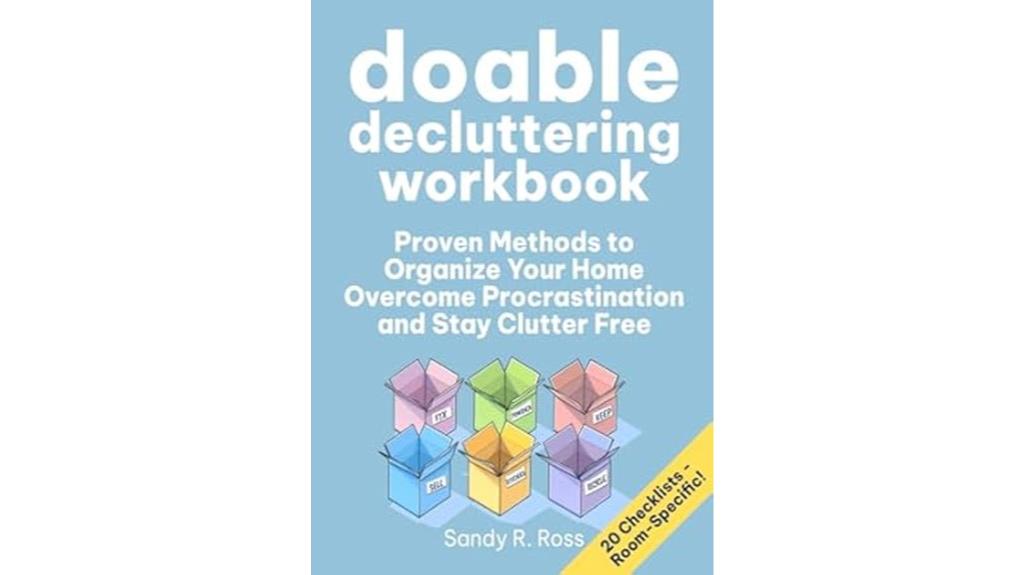
The "Doable Decluttering Workbook" is perfect for anyone grappling with the overwhelming task of organizing their home but unsure where to start. This workbook offers a step-by-step process that helps you overcome procrastination while maintaining a clutter-free space. It addresses the emotional connections we have with our belongings, guiding you through compassionate decluttering. With practical strategies like the 6-Box System and room-by-room checklists, you can tackle your clutter at your own pace. I've found the supportive prompts and personal adaptations immensely helpful, making my decluttering journey not just effective but also deeply rewarding.
Best For: The "Doable Decluttering Workbook" is best for individuals struggling with clutter who need structured guidance and motivation to organize their living spaces.
Pros:
- Step-by-step process helps users overcome procrastination and start decluttering effectively.
- Compassionate approach addresses emotional connections to belongings, making the process more relatable and manageable.
- Flexible strategies allow for personal adaptation, catering to individual needs and preferences.
Cons:
- Some readers may find that not all tips resonate with their unique situations.
- The workbook may feel overwhelming for those who prefer a more minimalist approach to decluttering.
- Progress tracking may not be necessary for everyone, potentially leading to disengagement for some users.
Declutter Your Home: Make more room for life
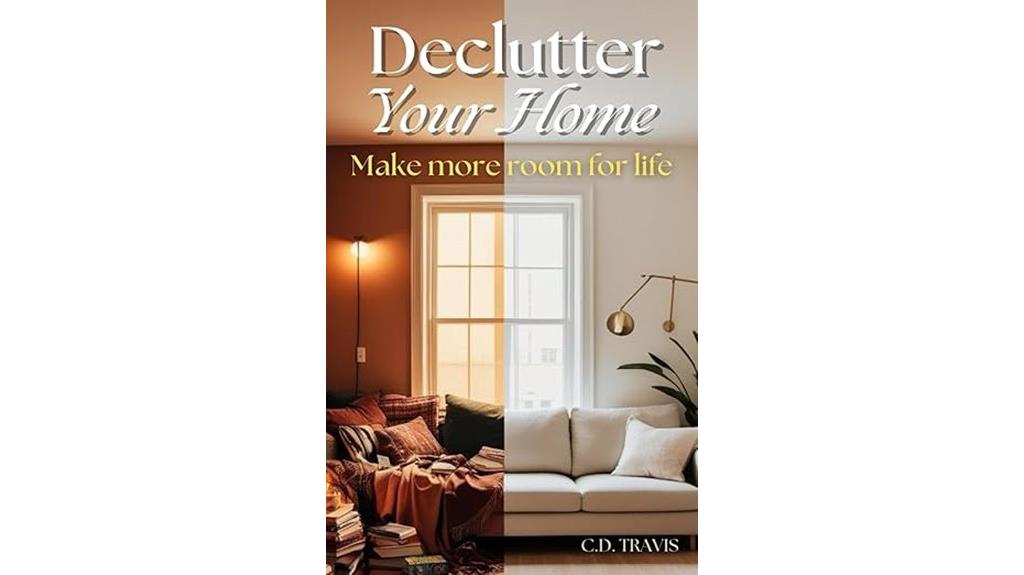
If you're overwhelmed by clutter and seeking a fresh start, "Decluttering Products for a Clutter-Free Life" might be just what you need. This book offers simple strategies like the Rule of Three and 10-minute daily tasks to help you tackle your space. I found the tips for managing sentimental items and small space storage particularly helpful. Involving family members makes decluttering a shared goal, which is great for teaching kids about organization. A clutter-free environment not only reduces stress but also boosts productivity. Immerse yourself in this book, and you'll create more room for what truly matters in your life.
Best For: Individuals and families looking to simplify their lives and create a clutter-free home environment.
Pros:
- Offers practical strategies like the Rule of Three and quick daily tasks for easy decluttering.
- Encourages family involvement, making organization a shared responsibility.
- Highlights the psychological benefits of a clutter-free space, such as reduced stress and increased focus.
Cons:
- May not provide advanced techniques for those already familiar with decluttering methods.
- Some readers might find the 10-minute daily tasks insufficient for larger clutter challenges.
- The focus on minimalism may not resonate with those who prefer a more maximalist approach to home decor.
Get Rid of the Mess: Decluttering Book
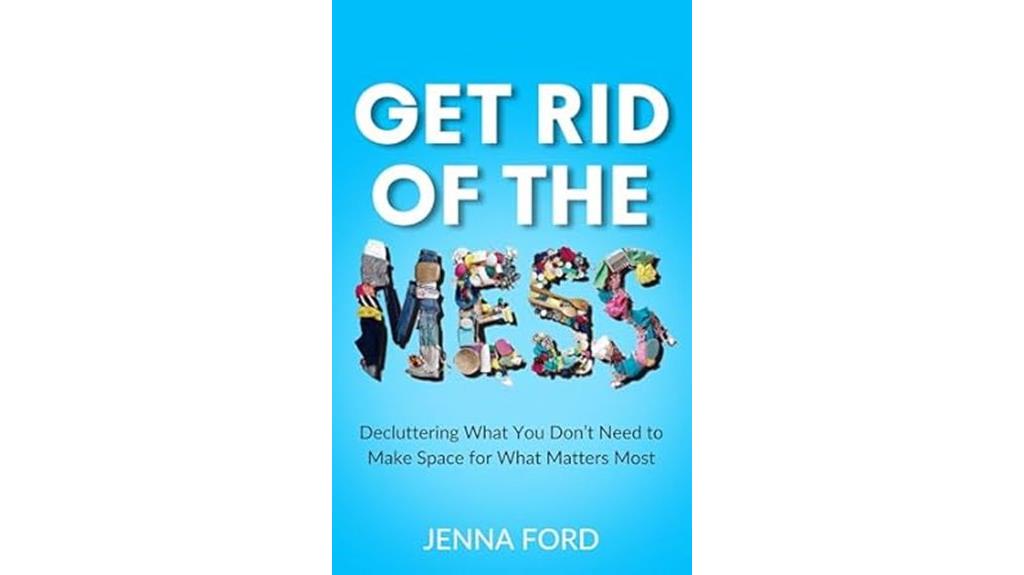
For anyone overwhelmed by clutter and unsure where to start, the "Get Rid of the Mess: Decluttering Book" is a perfect guide. It breaks down decluttering into manageable steps, offering room-by-room strategies that I found truly helpful. The author shares personal stories, making the journey relatable and encouraging. I appreciated the worksheets and charts that simplify decision-making about what to keep, donate, or toss. Plus, it addresses the emotional roadblocks we face. With insights on maintaining a clutter-free space, this book equips us to reclaim our homes and well-being for the long haul. It's a must-have for anyone ready to change!
Best For: Anyone feeling overwhelmed by clutter and seeking a relatable, step-by-step guide to decluttering their space.
Pros:
- Provides practical room-by-room strategies and helpful worksheets to simplify the decluttering process.
- Addresses the emotional aspects of clutter, helping readers overcome psychological barriers.
- Shares personal stories from the author that foster relatability and motivation for readers.
Cons:
- May not offer solutions for extreme hoarding situations that require professional help.
- Some readers may find the emotional insights less applicable if they are primarily looking for practical tips.
- The focus on personal anecdotes may not resonate with those who prefer a more straightforward, technical approach.
Tidy Spaces, Peaceful Mind: The Art of Decluttering
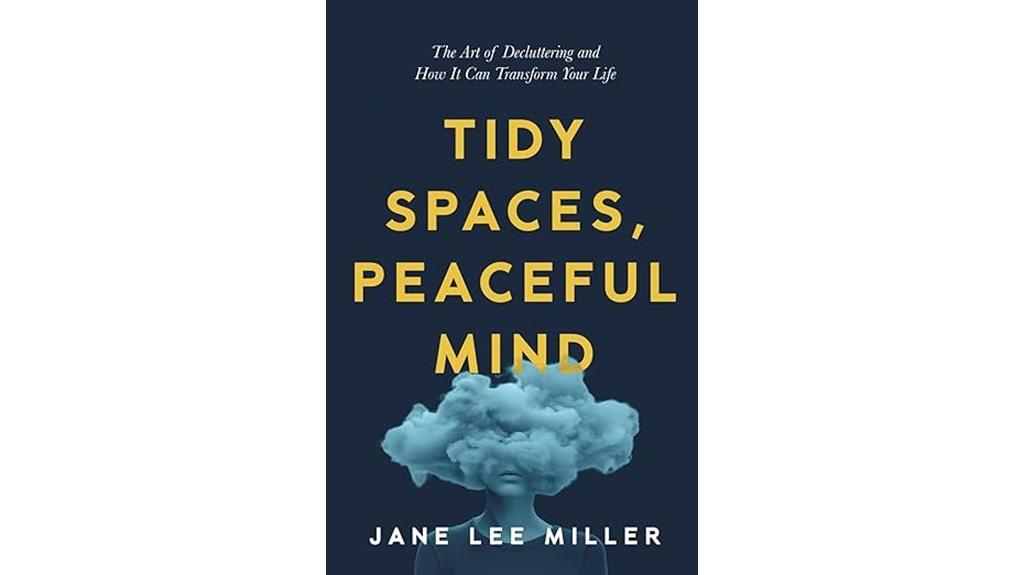
Creating a serene living space is essential for anyone feeling overwhelmed by chaos and clutter. "Tidy Spaces, Peaceful Mind" by Jane Lee Miller offers clear guidance for those ready to reclaim their environments and minds. Miller's practical strategies, like micro-decluttering, help break down tasks into manageable steps. By focusing on one area at a time, I've found it easier to maintain order. The book also emphasizes the mental benefits of a tidy space, reducing stress and fostering mindfulness. With its casual tone and supportive insights, I felt inspired to view decluttering as an empowering journey, not just another chore.
Best For: Individuals seeking to create a more organized and peaceful living environment while enhancing their mental well-being through decluttering.
Pros:
- Offers practical, step-by-step strategies that make decluttering manageable.
- Highlights the psychological benefits of a tidy space, promoting mindfulness and stress reduction.
- Engaging and motivational writing style encourages readers to see decluttering as an empowering journey.
Cons:
- Some readers may find certain sections repetitive or overly chatty.
- Lack of real-life anecdotes may limit relatability for some readers.
- Minimal exploration of digital decluttering and absence of visual aids for deeper understanding.
Factors to Consider When Choosing 8 Decluttering Products for a Clutter-Free Life
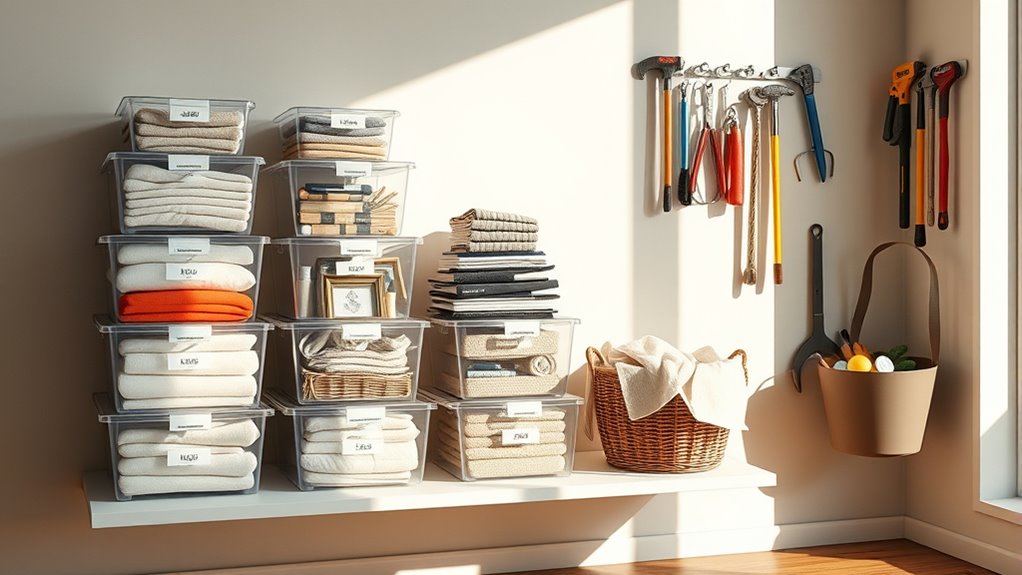
When I'm picking out decluttering products, I always start by defining my goals and figuring out the space I have. It's also important to me to prioritize solutions that are multi-functional and fit my aesthetic. Plus, I make sure to evaluate the durability and quality because I want these products to last.
Define Your Decluttering Goals
Defining my decluttering goals has been a game changer in my journey toward a clutter-free life. I realized that having clear objectives helps me create a focused plan, making it easier to decide what to keep, donate, or discard. I consider which areas of my home need attention, whether it's reducing emotional clutter or simply making more space. Setting measurable goals, like decluttering a specific room within a month, really boosts my motivation. I prioritize tasks based on urgency or emotional impact, tackling the most significant clutter first. Regularly revisiting my goals allows me to adapt to my evolving lifestyle, ensuring that my clutter-free environment remains sustainable and aligned with my aspirations.
Assess Available Space
With my decluttering goals set, the next step is to assess the available space in my home. I measure the dimensions of rooms, closets, and storage areas to guarantee my decluttering products fit without overcrowding. I also consider the layout and flow of each area, keeping in mind how frequently I use those spaces. Evaluating existing furniture helps me identify underutilized areas, like corners or vertical spaces. I take inventory of items I want to declutter and categorize them by size and type, which guides my storage solution choices. Finally, I'm mindful of both the aesthetic and functional aspects, ensuring that my chosen products enhance my environment rather than detract from it.
Prioritize Multi-Functional Solutions
As I dive deeper into my decluttering journey, I realize how essential it is to prioritize multi-functional solutions. These products save space by combining multiple functions into one, which drastically reduces the number of items I need. For instance, using furniture like ottomans or coffee tables with storage compartments not only declutters my living area but also keeps it stylish. I love how a shelving unit can double as a room divider, maximizing utility in smaller spaces. Additionally, choosing collapsible storage bins allows me flexibility as my organizing needs change. By implementing these multi-functional solutions, I enhance my space's efficiency while embracing a minimalist approach, creating a more peaceful and clutter-free environment.
Consider Storage Aesthetics
How can I make my storage solutions both functional and aesthetically pleasing? I've found that prioritizing storage aesthetics greatly enhances my space. When I choose storage options that complement my existing furniture and design elements, the entire room feels more inviting and organized. Color matters too; lighter shades create openness, while darker tones add warmth. I love incorporating decorative storage solutions like woven baskets or stylish bins, as they're both functional and decorative. This approach reduces visual clutter and contributes to a peaceful environment. Thoughtfully designed storage not only keeps my belongings in check but also elevates the overall décor, making my home a more enjoyable place to be.
Evaluate Durability and Quality
When I choose decluttering products, I always prioritize durability and quality because they directly impact the effectiveness of my organization efforts. I look for materials that resist wear and tear, ensuring they can handle regular use without breaking down. Products with warranties or guarantees signal a manufacturer's confidence in their longevity, which I find reassuring. I also explore user reviews, focusing on comments about performance over time to gauge real-world durability. Specialized items tend to outperform generic alternatives, so I opt for those designed for specific tasks. Additionally, I assess the weight and sturdiness of products; heavier, well-constructed items generally offer greater stability, which enhances their overall durability in my home organization journey.
Budget and Cost Efficiency
Choosing decluttering products without a clear budget can lead to overspending and frustration. I always set a budget that reflects my financial situation, ensuring I don't waste money on items that lack real value. I've found that investing in multifunctional or space-saving products pays off in the long run, as they minimize the need for additional storage solutions. It's essential to evaluate the durability and quality of the products I choose; sometimes, a higher upfront cost is worth it for long-lasting effectiveness. I also look for items with warranties or satisfaction guarantees to protect my investment. Finally, I compare prices across different retailers, as similar products can vary considerably, ensuring I get the most cost-effective options.
Ease of Use
Setting a budget is just the first step toward a clutter-free life; the next is ensuring the decluttering products I choose are easy to use. I want tools that simplify the organizing process, making it feel less intimidating. Products with intuitive designs or clear instructions help me engage without feeling overwhelmed. I've noticed that quick assembly and straightforward operation lead to immediate results, which keeps my motivation high. Lightweight materials and ergonomic designs make handling these products a breeze. Streamlined options that eliminate complicated setups or excessive decision-making really enhance my decluttering routine. By prioritizing ease of use, I can maintain a clutter-free space without the stress that often accompanies organizing tasks.
Frequently Asked Questions
How Do I Maintain a Clutter-Free Lifestyle Long-Term?
Maintaining a clutter-free lifestyle long-term can be challenging, but I've found a few strategies that help. I make it a habit to regularly assess my belongings, keeping only what I truly need or love. I also set aside time each week to declutter, ensuring my space stays organized. Additionally, I've learned to be mindful of new items I bring in, asking myself if they truly add value to my life.
What Are the Psychological Benefits of Decluttering?
Did you know that 40% of people feel overwhelmed by their clutter? When I declutter, I notice a significant boost in my mood and focus. It's like a weight lifts off my shoulders. The process helps me regain control over my environment, reduces anxiety, and promotes a sense of accomplishment. I've found that a clear space leads to a clearer mind, making it easier to think and be productive in my daily life.
Can Decluttering Improve Productivity at Work?
Absolutely, decluttering can greatly improve productivity at work. I've experienced it firsthand; when I clear my workspace of unnecessary items, I feel more focused and less distracted. A tidy environment fosters clarity and allows me to prioritize tasks effectively. I've noticed that my creativity flows better in an organized space, too. So, if you're looking to boost your productivity, consider spending some time decluttering your work area – it really makes a difference!
How Often Should I Reassess My Decluttering Efforts?
Did you know that people who reassess their clutter every six months report a 30% increase in overall happiness? I find it crucial to regularly evaluate my decluttering efforts. I usually do this every three to six months, depending on how much I've accumulated. This way, I stay mindful of what I truly need and can adapt my spaces as my lifestyle changes. Regular reassessment keeps my environment fresh and functional.
What to Do With Sentimental Items While Decluttering?
When I tackle sentimental items while decluttering, I first evaluate their importance. I ask myself if they spark joy or hold significant memories. If they do, I consider keeping a few special pieces and photographing others. It helps to create a memory box for the most cherished items. I've found that letting go of the rest frees up space, allowing me to cherish those memories without cluttering my home.
Conclusion
In my journey toward a clutter-free life, I've learned that "less is more" really rings true. Each of these decluttering products has played an essential role in simplifying my space and mind. By choosing the right tools and adopting a mindful approach to what I keep, I've created an environment that truly reflects my priorities. I encourage you to take the plunge—embrace decluttering and discover the freedom and peace that comes with a tidy home!
